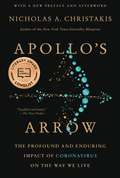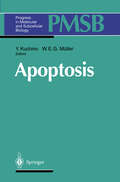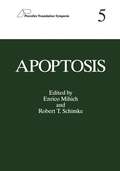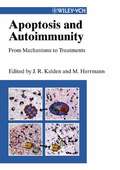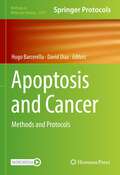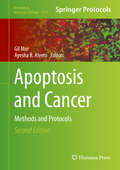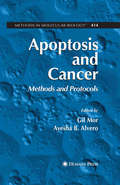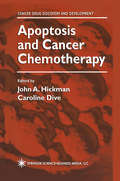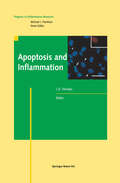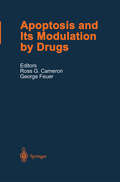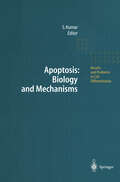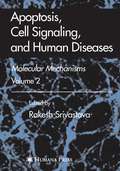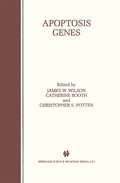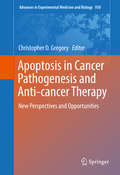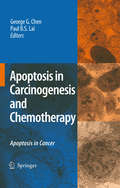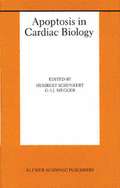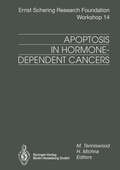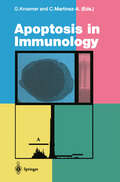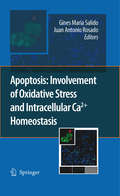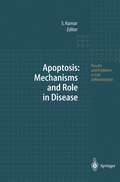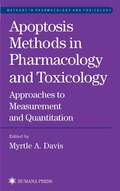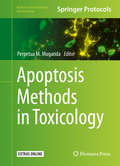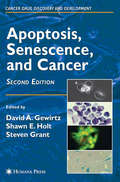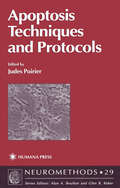- Table View
- List View
Apollo's Arrow: The Profound and Enduring Impact of Coronavirus on the Way We Live
by Nicholas A. ChristakisA piercing and scientifically grounded look at the emergence of the coronavirus pandemic and how it will change the way we live — "this year's must-must-read." (Daniel Gilbert) Apollo's Arrow offers a riveting account of the impact of the coronavirus pandemic as it swept through American society in 2020, and of how the recovery will unfold in the coming years. Drawing on momentous (yet dimly remembered) historical epidemics, contemporary analyses, and cutting-edge research from a range of scientific disciplines, bestselling author, physician, sociologist, and public health expert Nicholas A. Christakis explores what it means to live in a time of plague — an experience that is paradoxically uncommon to the vast majority of humans who are alive, yet deeply fundamental to our species. Unleashing new divisions in our society as well as opportunities for cooperation, this 21st-century pandemic has upended our lives in ways that will test, but not vanquish, our already frayed collective culture. Featuring new, provocative arguments and vivid examples ranging across medicine, history, sociology, epidemiology, data science, and genetics, Apollo's Arrow envisions what happens when the great force of a deadly germ meets the enduring reality of our evolved social nature.
Apollo's Arrow: The Profound and Enduring Impact of Coronavirus on the Way We Live
by Nicholas A. ChristakisA piercing and scientifically grounded look at the emergence of the coronavirus pandemic and how it will change the way we live — "excellent and timely." (The New Yorker) Apollo's Arrow offers a riveting account of the impact of the coronavirus pandemic as it swept through American society in 2020, and of how the recovery will unfold in the coming years. Drawing on momentous (yet dimly remembered) historical epidemics, contemporary analyses, and cutting-edge research from a range of scientific disciplines, bestselling author, physician, sociologist, and public health expert Nicholas A. Christakis explores what it means to live in a time of plague — an experience that is paradoxically uncommon to the vast majority of humans who are alive, yet deeply fundamental to our species.Unleashing new divisions in our society as well as opportunities for cooperation, this 21st-century pandemic has upended our lives in ways that will test, but not vanquish, our already frayed collective culture. Featuring new, provocative arguments and vivid examples ranging across medicine, history, sociology, epidemiology, data science, and genetics, Apollo's Arrow envisions what happens when the great force of a deadly germ meets the enduring reality of our evolved social nature.
Apoptosis (Progress in Molecular and Subcellular Biology #16)
by Y. Kuchino W. E. G. MüllerApoptosis plays a central role in the regulation of cell proliferation. Disruption of this control mechanism may cause serious human diseases such as encephalomyelitis and cancer. Thus, understanding of the molecular mechanisms of apoptotic cell death should lead to fundamental advances in the therapy of these diseases.
Apoptosis (Pezcoller Foundation Symposia #5)
by Enrico Mihich Robert T. SchimkeThe fifth Annual Pezcoller Symposium entitled, Apoptosis, was held in Trento, Italy, June 9-1I, 1993 and was focused on the specific phenomena leading to Programmed Cell Death (PCD) or Apoptosis, and the mechanisms involved. With presentations at the cutting edge of progress and stimulating discussions, this Symposium addressed the genetics and molecular mechanisms determining PCD and the role of this suicidal process in cancer and the immune system. The functions of pS3, c myc and bel 2 in affecting apoptosis in different cell types and the role of ions and intracellular pH changes and that of intranuelear endonueleases are given particular emphasis as are the effects of anticancer agents, hormone imbalances and growth factors. The role of pS3, a tumor suppressor gene, in inducing PCD is discussed in detail as pertinent to hematological and non-hernatological tumors. The requirement of pS3 for the induction ofapoptosis by ionizing radiation or adenovirus oncoproteins is outlined. Decision points during the cell cyele affecting the cascade ofevents leading to PCD are discussed as is their role as "switches" under the control of c-myc and bel-2 proteins or the influence of cyele specific drugs. The concurrent requirement of multiple signals in determining apoptosis is emphasized. The examples of the role of PCD in the regulation of hematopoiesis, and in the generation of antigen-specific immune repertoire are illustrated.
Apoptosis and Autoimmunity: From Mechanisms to Treatments
by Joachim R. Kalden Martin HerrmannThis is the first comprehensive book about the relationship between apoptosis and autoimmune diseases. It offers a unique up-to-date overview on research results on the defective execution of apoptosis and the incomplete clearance of apoptotic cells. The molecular and cellular mechanisms involved are described in detail. As a possible consequence of apoptotic dysfunction, the development of severe autoimmune diseases (e.g., rheumatoid arthritis, systemic lupus erythematosus) is discussed. An outlook on future research topics includes the evaluation of novel therapeutic strategies.
Apoptosis and Cancer: Methods and Protocols (Methods in Molecular Biology #2543)
by Hugo Barcenilla David DiazThis volume discusses methods used in the fields of molecular and cellular biology for detecting and studying cell death, especially in cancer and cancer therapy. Chapters in this book cover topics such as non-destructive, real-time Annexin V apoptosis assay; assessment of the immune response to tumor cell apoptosis and efferocytosis; mass cytometry assessment of cell phenotypes and signaling states in human whole blood; cell cycle analysis of ER stress and autophagy; and simultaneous detection of inflammasome activation and membrane damage during pyroptosis. Written in the highly successful Methods in Molecular Biology series format, chapters include introductions to their respective topics, lists of the necessary materials and reagents, step-by-step, readily reproducible laboratory protocols, and tips on troubleshooting and avoiding known pitfalls.Cutting-edge and practical, Apoptosis and Cancer: Methods and Protocols is a valuable resource and practical guide for both novice and expert researchers looking into the “meaning of death.”
Apoptosis and Cancer: Methods and Protocols (Methods in Molecular Biology #1219)
by Gil Mor and Ayesha B. AlveroIn Apoptosis and Cancer: Methods and Protocols, Second Edition, expert researches in the field detail the performance of molecular and cellular biology techniques for studying and detecting the activation of the apoptotic pathway. Chapters focus on assays developed to detect its activation not only in vitro but also in vivo, optimized multiplex analysis, medium- to high-throughput screens, and the cellular process. Written in the highly successful Methods in Molecular Biology series format, chapters include introductions to their respective topics, lists of the necessary materials and reagents, step-by-step, readily reproducible laboratory protocols, and key tips on troubleshooting and avoiding known pitfalls.Authoritative and practical, Apoptosis and Cancer: Methods and Protocols, Second Edition aids scientists as a stand-alone resource for the execution and analysis of the described protocols and as a reference for the study and detection of apoptosis within and outside the area of cancer research.
Apoptosis and Cancer: Methods and Protocols (Methods in Molecular Biology #414)
by Gil Mor and Ayesha B. AlveroThe aim of Apoptosis and Cancer is to describe the performance of contemporary techniques for studying the biology of apoptosis and its role in cancer. The protocols described will aid both the academic laboratory interested in further characterizing the mechanisms of apoptosis, as well as the industry laboratory, aimed at identifying new target molecules or screening for new compounds with potential clinical use.
Apoptosis and Cancer Chemotherapy (Cancer Drug Discovery and Development)
by John A. Hickman Caroline DiveThe past few years have witnessed an astonishing international effort that established the role of some 20 new molecules in apoptosis and added activation or suppression of apoptosis to the accepted biological functions of a great many others already familiar in cancer biology. Some of these molecules are receptors, transducing cytokine-mediated signals; others appear to intensify or diminish the risk that a compro mised cell will fire its apoptosis effector mechanism. All are of interest as potential targets for tumor therapy, and some may prove to be control points influenced in the pathogenesis of cancer and other diseases as diverse as viral infection, neurodegenerative disorders, and stroke. Sometimes, in the midst of these developments, a kind of euphoria ap pears to have gripped the research community, with the expectation that apoptosis will afford explanations to many unsolved questions in cellu lar regulation. This book, in a series of thoughtful and provocative ar ticles--some from established leaders in the field, and others from younger scientists--seeks to redress the balance.
Apoptosis and Inflammation (Progress in Inflammation Research)
by James D. WinklerApoptosis is a form of cell death that occurs in a controlled manner and is generally noninflammatory in nature. Apoptosis, or programmed cell death, implies a cell death that is part of a normal physiological process of pruning of unneeded cells. However, many disease conditions utilize apoptosis for pathological ends, resulting in inappropriate cell death and tissue destruction. This book starts with an introduction that reviews the general characteristics of apoptosis, its regulation and its role in physiology and disease. Next, the book focuses on three areas as they relate to inflammatory cells and diseases. The first area consists of chapters on signals for apoptosis important to inflammatory cells, namely growth factors and arachidonic acid metabolism. The next area that the book focuses on are effects at the cellular level, on cell survival versus cell death and signals critical for cell function in both normal and disease states. These topics are covered in chapters on lymphocytes, granulocytes, chondrocytes and keratinocytes. The last area that the book focuses on are events at the level of tissue and disease, looking at the evidence for altered apoptosis and/or apoptotic processes in immune and inflammatory diseases. These topics are covered in chapters on rheumatoid arthritis, osteoarthritis, lupus, psoriasis and renal disease. Together, these chapters will provide the reader with the latest insight in the role of apoptosis in inflammatory cells and diseases. This book starts with an introduction that reviews the general characteristics of apoptosis, its regulation and its role in physiology and disease. Next, the book focuses on three areas as they relate to inflammatory cells and diseases. The first area consists of chapters on signals for apoptosis important to inflammatory cells, namely growth factors and arachidonic acid metabolism. The next area that the book focuses on are effects at the cellular level, on cell survival versus cell death and signals critical for cell function in both normal and disease states. These topics are covered in chapters on lymphocytes, granulocytes, chondrocytes and keratinocytes. The last area that the book focuses on are events at the level of tissue and disease, looking at the evidence for altered apoptosis and/or apoptotic processes in immune and inflammatory diseases. These topics are covered in chapters on rheumatoid arthritis, osteoarthritis, lupus, psoriasis and renal disease. Together, these chapters will provide the reader with the latest insight in the role of apoptosis in inflammatory cells and diseases.
Apoptosis and Its Modulation by Drugs (Handbook of Experimental Pharmacology #142)
by Ross G. Cameron George FeuerApoptosis is a fascinating concept for the basic scientist. This is not only because of the multifaceted variety of proposed and discovered mechanisms, but because apoptosis represents a fundamental pathway for cell renewal. The study of apoptosis has resulted in an array of discoveries on signal transduc tion and downstream effects that have facilitated and advanced many fields in biology, including research on cancer and other diseases. Thus, the apoptotic process can be viewed as the largest effort of the scientific community to understand how cells work and tissues assemble or remodel. The most direct consequence of this accumulated knowledge is a greater understanding of disease and pathological mechanisms. The end result of these efforts will be significant contributions to health and the adoption of new, never anticipated, therapeutic approaches. This book represents the summation of considerable effort from a significant group of contributors from all over the world as well as from its editors. In this fashion, many viewpoints have been collected and SUbjected to thorough academic discussion. The concepts contained in this medically important volume will stimulate and renew the ideas of scientists and indeed, will generate additional work to advance biological knowledge even further. The emphasis of this volume cements what has been established, adds what has not been explored fully, and creates a fertile ground for further hypotheses that will lead to a more complete understanding of the apoptotic process.
Apoptosis: Biology and Mechanisms (Results and Problems in Cell Differentiation #23)
by S. KumarApoptosis is currently one of the fastest moving fields in biology with spectacular progress made over the past few years in delineating the molecular It is now indisputable that apoptosis mechanisms which underlie this process. plays an essential role in normal cell physiology and that aberrant apoptosis can manifest itself in a variety of human disorders. Published in two parts (Volumes 23 and 24 of the series entitled Results and Problems in Cell Differen tiation), this is an attempt to bring together many different aspects of apoptosis. Given that this is such a vast and rapidly expanding field, it is almost impossible to cover everything that is now known about apoptosis in two short books, but 1 hope these volumes prove to be a guidepost, providing basic essential information on the biology and molecular mechanisms of apoptosis and its implications in some human diseases. As a significant am o unt of new information on apoptosis is emerging every week, it is unrealistic to expect that by the time these two books are published, all the articles will deliver up-to-date information. Nevertheless, 1 believe that the fundamentals of the apoptotic phenomenon are now firmly in place and are discussed at length in various chapters. Readers may find a small degree of overlap between some chapters. This was unavoidable since closely related areas of apoptosis research have been covered by more than one author.
Apoptosis, Cell Signaling, and Human Diseases: Molecular Mechanisms, Volume 2
by Rakesh SrivastavaApoptosis, Cell Signaling, and Human Diseases: Molecular Mechanisms, Volumes 1 and 2, present a concise synthesis of recent developments in the understanding of both cell survival and apoptotic pathways. Particular attention is given to apoptosis in human diseases, such as different forms of cancer. These comprehensive volumes integrate the most innovative and current findings. The contributors are at the forefront of scientific discovery.
Apoptosis Genes
by Christopher S. Potten CatherineBooth James W. WilsonThis useful work presents a current overview of key genes involved in the control of apoptosis research together with thoughts on future prospects and clinical applications. While there are several books written on apoptosis, this one deals specifically with its regulation.
Apoptosis in Cancer Pathogenesis and Anti-cancer Therapy: New Perspectives and Opportunities (Advances in Experimental Medicine and Biology #930)
by Christopher D. GregoryThis book discusses properties of apoptosis and other cell death modalities in cancer pathogenesis and treatment. Its nine chapters discuss modulation of anti-tumor inflammatory and immune responses, effects on the tumor microenvironment, to strategies for improving pro-apoptotic therapies, mechanisms and implications for disease pathogenesis, axl and mer receptor tyrosine kinases, immunogenic apoptotic cell death and anti-cancer immunity and cancer cell death-inducing radiotherapy. This book places the onco-biology of apoptosis in clear and objective perspective through an expertly synthesized series of reviews.Apoptosis in Cancer Pathogenesis and Anti-cancer Therapy is a deft and thorough exploration of cutting-edge research in apoptosis and anti-cancer mechanisms from basic biology to oncology. It highlights a rapidly growing field within cancer research and is essential reading for oncologists, biochemists and advanced graduate students alike.
Apoptosis in Carcinogenesis and Chemotherapy: Apoptosis in cancer
by George G. Chen Paul B. S. LaiAlthough research on carcinogenesis has focused more on cellular proliferation than on cell death, yet understanding the mechanism of apoptosis may have important implications for cancer therapy. This book brings together experts from around the world who will discuss the common cancers encountered in clinical practice in the laboratory setting. During the induction of these common cancers, the role of apoptosis in cellular and molecular changes is emphasized, critically highlighting possible anti-cancer strategies. For those who are interested in carcinogenesis and for those who are seeking new approaches to anti-cancer therapy, this book is an important reference. It serves not only as a reference of the current understanding of apoptosis in common cancers but also an important bridge between the laboratory and clinical practice. The editors and contributors are to be congratulated in bringing together an important pool of up-to-date knowledge to light and further our interest in this exciting and expanding ?eld. Arthur K. C. Li Emeritus Professor of Surgery The Chinese University of Hong Kong v Preface The role of apoptosis in cancer development and emerging treatment strategies has rapidly expanded over the past few years. The novel discovery in the apoptotic pa- ways and their relevant molecules provides us not only the knowledge how tumors develop but also the opportunity to design new therapeutic tools to prevent or inhibit the growth of tumors with minimal side-effects. Undoubtedly, understanding the events involved at a molecular level can permit the manipulation of apoptosis for therapeutic purposes.
Apoptosis in Cardiac Biology (Basic Science for the Cardiologist #5)
by Heribert Schunkert G. A. J. RieggerApoptosis or programmed cell death is increasingly considered to be a major factor in the development and progression of cardiovascular disease. In patients with heart failure the activation of apoptosis may result in the loss of irreplaceable cardiac myocytes promoting the clinical course of the syndrome. Moreover, in the coronary arteries inflammation and apoptosis may weaken critical structures of the vessel wall leading to plaque rupture and, subsequently, to myocardial infarction. Given these deleterious consequences, it seems almost paradoxical that programmed cell death is an active process that, if initiated under physiological circumstances, is essential for both coordinated tissue growth or destruction of malignant cells. Apoptosis in Cardiac Biology, written by a team of internationally renowned researchers, gives a timely synopsis of basic mechanisms, cellular and structural targets and, finally, clinical implications of programmed cell death in the heart. The expert authors of this volume give concise overviews on general and cell-specific aspects of programmed cell death in cardiac myocytes and fibroblasts, as well as in vascular smooth muscle and endothelial cells. Furthermore, novel therapeutic options arising from the outstanding pathophysiological significance of cardiac apoptosis are presented. This comprehensive review of Apoptosis in Cardiac Biology will be of interest to both clinicians and basic researchers who are active in the fields of cardiology and atherosclerosis.
Apoptosis in Hormone-Dependent Cancers (Ernst Schering Foundation Symposium Proceedings #14)
by Horst Michna Martin TenniswoodIt is now widely accepted that cells have the ability to initiate a program of gene-directed death, a process called "apoptosis" which may also be used as an innovative strategy for therapeutic intervention in cancer therapy. Experts in this area report on the regulation and control of apoptosis in hormone dependent (neoplastic) tissue and the possibility to exploit active cell death for therapeutic application.
Apoptosis in Immunology (Current Topics in Microbiology and Immunology #200)
by Guido Kroemer Carlos Martinez-A.In any movement of their life, immune cells, especially T and B lymphocytes, are confronted with an essential choice: to continue their existence or to commit a sort of metabolic suicide that is referred to as apoptosis or programmed cell death. In contrast to most philosophers, lymphocytes and their precursors are constantly susceptible to suicide, and it even appears that the usual cause of T or B cell elimination is suicide rather than death from natural causes, accidents or murder. This book provides a vast overview of lymphocytes suicide: external triggers and internal motives leading to suicidal impulses, accomplices in self-destruction, weapons implicated in self-execution, removal of dead bodies and pharmacological prevention of suicide. Most of the chapters in this book are devoted to the physiology of apoptosis. The goal is to unmask the external triggers of apoptosis, unravel the signal transduction pro cesses involved therein and describe the role of oncogenes, "death genes" and effector molecules in the apoptotic cas cade. The remaining chapters deal with the pathophysiologi cal aspects of lymphocyte apoptosis, namely, as a host contribution to HIV-induced lymphopenia, and therapeutic strategies for the avoidance of lymphocyte death. We are confident that this compendium will contribute to the exploration of cellular suicide, not only from a basic scientist's viewpoint but also with regard to the possible clinical implications of apoptosis (dys)regulation. Far from having a depressing effect on the reader, cellular suicide may thus provide a source of both intellectual excitement and therapeutic inspiration.
Apoptosis: Involvement of Oxidative Stress and Intracellular Ca2+ Homeostasis
by Gines Maria Salido Juan Antonio RosadoApoptosis: Involvement of Oxidative Stress and Intracellular Ca2+ Homeostasis, presents a concise synthesis of the current knowledge and recent advances in the mechanisms of apoptosis in different cells and the role of oxidative stress and Ca2+ signalling. Particular attention is given to the different features of apoptosis in distinct cell types, ranging from hepatocytes to cardiovascular and blood cells, nervous cells or spermatozoa. Cutting-edge and user-friendly, this volume serves as a comprehensive resource for those interested in the fascinating biological processes associated to programmed cell death or apoptosis. The book is divided in two major chapter sections: general mechanisms of the apoptotic pathways and the role of oxidative stress and intracellular Ca2+ homeostasis and a more specific section dedicated to the specificities of apoptosis in a number of excitable and non-excitable cells. All of the contributions are from specialists in the field and the reviews presented, systemically examine the most exciting and innovative aspects of the apoptotic pathways in their particular areas of expertise.
Apoptosis: Mechanisms and Role in Disease (Results and Problems in Cell Differentiation #24)
by Sharad KumarApoptosis Methods in Pharmacology and Toxicology: Approaches to Measurement and Quantification (Methods in Pharmacology and Toxicology)
by Myrtle A. DavisDr. Myrtle A. Davis has assembled a panel of cutting-edge scientists to describe their best methods for detecting, illuminating, and quantifying apoptotic mechanisms in a way that is useful for the design of toxicology and pharmacology studies. These state-of-the-art techniques include flow cytometric, fluorometric, and laser scanning methods for quantifying and characterizing apoptosis, as well as protocols for the use of DNA microarray technology, high throughput screens, and ELISA. Immunocytochemical methods for measuring biochemical and molecular endpoints in tissue sections will be highly useful for those carrying out studies in whole animal models as opposed to cell culture systems.
Apoptosis Methods in Toxicology (Methods in Pharmacology and Toxicology)
by Perpetua M. MugandaThis detailed volume provides a single, valuable reference source for methods that definitively identify and accurately quantify apoptosis. The book begins with common methods utilized to detect and quantitate apoptosis, as well as apoptosis signaling pathways in toxicological and other related research. It continues with multi-parametric and phased apoptosis assays for detecting early and late apoptosis or distinguishing apoptosis from necrosis and autophagy. Subsequent chapters focus on recent advances in real time and high-throughput assays that detect and quantitate apoptosis and apoptosis signaling pathways. Final chapters focus on recent developments in preclinical anticancer therapeutics targeting apoptosis. Written for the Methods in Pharmacology and Toxicology series, chapters feature step-by-step descriptions of the methodologies, as well as expert tips and implementation advice. Vital and authoritative, Apoptosis Methods in Toxicology serves novice scientists as well as experts, utilizing a range of instruments from common laboratory equipment to high-end expensive and automated machinery capable of performing real time apoptotic measurements.
Apoptosis, Senescence and Cancer (Cancer Drug Discovery and Development)
by David A. Gewirtz Shawn E. Holt Steven GrantThis book provides insight into established practices and research into apoptosis and senescence. The volume thoroughly examines novel and emerging techniques and research in the fields of cell death pathways, senescence growth arrest, drugs and resistance, DNA damage response, and other topics that still hold mysteries for researchers. In total, this volume provides basic scientists and clinicians with a deeper and more complete understanding of the cellular responses of malignancies which may determine the effectiveness of treatment, both in the initial stages of the disease as well as in disease recurrence.
Apoptosis Techniques and Protocols (Neuromethods #29)
by Judes PoirierAfter many years of neglect, the study of normal cell death and the so-called programmed cell death has finally gained some needed momentum. Evidence obtained over the last five years indicates that programmed cell death (also referred to as apop tosis) occurs normally in most animal tissues at some we- defined stages of their development and/or maturation. The molecular mechanisms by which it is executed remains - known. However, key regulatory and metabolic steps have been identified in the apoptotic cascade and a central concept has progressively emerged: Apoptosis appears to occur by default in many different cell types unless suppressed by signals ori- nating from neighboring cells. As Martin Raff noted a few years ago, this molecular cascade probably imposes a form of social control on cell survival and cell death. Since our understanding of the apoptosis phenomena has grown significantly over the last few years, we have been - powered by recent technological advances to biochemically d- sect the key metabolic components of apoptotic and necrotic cascades in normal and injured brains. Moreover, the devel- ment of improved histochemical tools has allowed us to better define the fundamental criteria of cell death, and transgenic te- nology has allowed scientists to test working hypotheses p- taining to the mechanism of action of the so-called “cell death gene.
